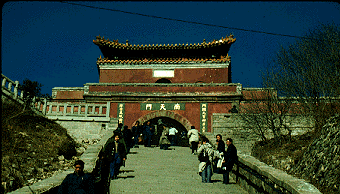 The last gate before heaven, located at the top of the main route.
The last gate before heaven, located at the top of the main route.
Tai Shan and Imperial Rituals:
Known as the Mount of the East, the Mountain of the Gods, and the Eastern Peak of Heaven, Taishan rises 1,545 meters above the city of Tai’an in Shandong province, the tallest of a mountain range covering 426 square kilometers. According to myths, Mount Tai, the easternmost of the five sacred Taoist mountains, is governed by the Grand Emperor of the Eastern Peak who rules earth and men. During the first centuries of the Christian era he became briefly associated with the world of the dead. Temples house images of the Grand Emperor of the Eastern Peak sitting in formal imperial costume. His daughter is the Princess of Multi-Colored/Azure Clouds (Bixia), worshipped by peasant women as their protectress.
The emperor’s ascent of Taishan bonded the deities with the dynasties. During the Xia, Shang, and Zhou dynasties 72 monarchs trekked to Taishan to pray, only five reaching the top. All constructed temples, erected stone calligraphy tablets, composed and commissioned poetry and artwork. The Dai Temple, Wangmu Pool, Hongmen Palace, Zhongtianmen – South Heavenly Gate, and the Bixia Temple evidence the traces of these leaders. The feng and the shan, two sacrifices executed by the Emperor on Taishan, symbolized the heavenly approval of the Emperor’s deeds and his dynasty. The Emperor prayed to Heaven in the feng sacrifice and to Earth in the shan sacrifice. Heaven would never allow an unworthy sovereign to ascend Taishan. Doubtful emperors urged by their court to go to Taishan feared Heaven’s wrath. The legendary Emperor Shun had performed the feng and shan sacrifices around 2255 – 2205 BC . Emperor Shih Huang Ti of the Qin Dynasty had attempted the two sacrifices, but fled in violent storms. Wu Ti of the Han Dynasty revived the forgotten rites, performing the sacrifices in 110 BC, 106 BC, and 98 BC. The Late Han Dynasty Emperor Kuang-wu reluctantly made the sacrifices in 56 AD. Wen Ti, Emperor of the Sui Dynasty, begged pardon from his faults, performing smaller sacrifices to Heaven at the foot of Taishan in 595. Tai-tsung, the second emperor of the Tang Dynasty, failed in each of his three efforts. On new year’s day 666 Tai-tsung’s son, Kao-tsung, completed the feng and shan sacrifices for the first time in 610 years. His wife, Empress Wu, set the precedent as a woman participant, aiming for proof of her virtue. Eventually, rulers forgot the imperial feng and shan sacrifices, but not Taishan itself.
The foot to the summit of Taishan measures 24 kilometers, traversed by cablecars, minibuses, buses, and over 6,000 stone steps. Three main gates mark the pathway – I Tianmen, Zhongtianmen, and Nantianmen (First, Second, and Third Heaven Gates) with three guesthouses – Taishan, Zhongtianmen, and Shenqi – welcoming travelers. Two main paths lead up the mountain, converging at Zhongtianmen. The lesser traveled western route boasts few structures. The central route chronicles China’s past through temples, calligraphy stones, and historic memorials. Vendors crowd the mountain path, announcing the new era of China.